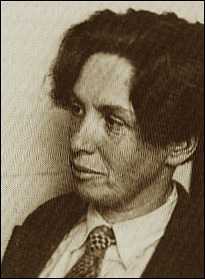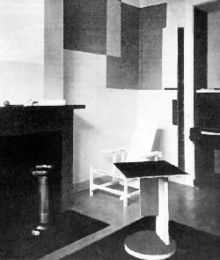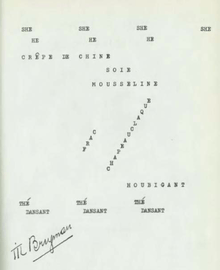Til Brugman
| Til Brugman | |
|---|---|
 Til Brugman | |
| Born |
Mathilda Maria Petronella Brugman 16 September 1888 Amsterdam, Netherlands |
| Died |
24 July 1958 Gouda, Netherlands |
| Nationality | Dutch |
| Awards | Marianne Philips Prize - Novels Prize, Amsterdam |
Mathilda (Til) Brugman (16 September 1888, Amsterdam - 24 July 1958, Gouda) was a Dutch author, poet and linguist.
Biography
Born in Amsterdam in 1888, Mathilda Maria Petronella Brugman, or Til, was the oldest of nine children in a Roman Catholic family. Her father dealt in wine and spirits and owned vineyards in the South of France and Spain. Brugman’s parents encouraged their daughter’s gift for languages from an early age. Her mother taught her to read, and Til’s father taught her to speak French by the time she was three. Til’s father was Hermanus Johannes Brugman (1852–1931), and her mother was Adriana Geertruida Johanna Zoons (1859–1939). In contrast to her father’s easy going cosmopolitanism, Brugman’s mother was close minded, which Til attributed to her mother’s staunch Catholicism. This alienated the young Brugman and caused her to leave home in anger. In 1911, Til rented a room in Amsterdam and supported herself as a secretary and translator. In 1917, Brugman moved to Den Haag and set up residence with her first lesbian partner, the Dutch concert singer Sienna Mastoff (1892–1959). Brugman lived with Mastoff until she met the German Dada artist Hannah Höch in 1926. Her last partner was Hans Mertineit-Schnabel.
The Avant-garde and the Literary Grotesque
Til Brugman’s earliest contacts with the artistic avant-garde were through Piet Mondrian (1872–1944), whom she met in Amsterdam at dance lessons in 1908. Soon, Brugman became acquainted with a number of writers, architects, and artists affiliated with Dutch Dada and De Stijl circles. Brugman co-authored Dutch Dada manifestos and translated a number of articles for the magazine De Stijl, but was rarely acknowledged or credited by contemporaries for her contributions. Til Brugman managed Kurt Schwitter’s magazine Merz in the Netherlands, and helped her colleagues sell their work, finding buyers for Schwitters, Hans Arp (1886–1966), El Lissitzky (1890–1941) and Piet Mondrian. Til Brugman’s sound poems, which she began to write in the teens, and her use of experimental typographic techniques, reflect her proximity to notable avant-garde figures. Moreover, they cogently represent theories regarding the roots of avant-garde typography, which “are entwined with those of twentieth-century painting, poetry, and architecture.” In addition to reflecting her ties to leading international avant-garde figures, Brugman’s early artistic productionalso demonstrates her remarkable linguistic abilities. Fluent in more than a dozen languages, Brugman’s sound poems were published in Dutch, German, and French magazines. “W” was published in De Stijl and Merz in 1923, and in 1924, “Engin d’Amour” was printed in the Lyonnaise magazine Manomètre positioning Brugman among other avant-garde artists who engaged with the theme of mechanized sexuality and love. Til Brugman’s English and French language poem “SHE HE” not only offers evidence of her playful command of foreign languages, but, like “Engin d’Amour” also deploys sophisticated typographic techniques. Through contrasting masculine and feminine coded words, “SHE HE” suggests the social and sartorial exchange of men and women at a fashionable thé dansant. Soon after she met Höch in 1926, Brugman began writing in German; moreover, it is likely that Höch was instrumental in inspiring her to take up the literary grotesque genre. While affiliated with the Berlin Dadaists, Höch had experimented in this genre. Although Höch’s graphic oeuvre far outweighs her literary production, the artist wrote grotesques. While only a fraction of Brugman’s grotesques have been published, those that have attest to her distinctive literary contribution. Brugman engaged with a variety of themes exposing and examining the dangers of capitalism, consumer culture, sexism, and the unfortunate plight of sexual minorities. The author addressed the ruthless control and exploitation of women’s bodies and embedded a powerful feminist subtext in her 1927 grotesque “Himilia.” Brugman’s “Schaufensterhypnose” (Shop-window Hypnosis) satirizescapitalist-driven consumerism. In “Warenhaus der Liebe” (Department Store of Love) Brugman lampoons, yet simultaneously praises, Magnus Hirschfeld’s Institute for Sexual Science. In all three texts, Brugman’s voice counters that of the uncritical mainstream with satire and dark humor.

Information
- From 1926 to 1936 she lived in The Hague and later in Berlin with the German Dada artist Hannah Höch.[1]
- In 1935 she published Scheingehacktes: Grotesken mit Zeichnungen von Hannah Höch.
- In her appartement in The Hague, the music room was designed by Vilmos Huszár and supplemented with unique furniture of Gerrit Rietveld. A White Chair was designed by Gerrit Rietveld as a special commission for Til Brugman in 1923. Before Dutch Chair Designer Gerrit Rietveld painted the Red and Blue Chair, he made several mono colored ones. In the room a multi-colored end table by Gerrit Rietveld was also included.
 Til Brugman's Music Room
Til Brugman's Music Room
Awards
In 1952 she received the Marianne Philips Prize and the Novels Prize (Amsterdam) for her work.
Bibliography

- Das vertippte Zebra : Lyrik und Prosa
- Schijngehakt : grotesken en novellen
- Even anders : vier rabbelverzen
- Lust en gratie
- 5 klankgedichten
- Tot hier toe en nog verder : notities
- Wat de pop wist
- Spiegel en lachspiegel
- Eenmaal vrienden altijd vrienden
- De zeebruid : roman
- Kinderhand
- De vlerken
- Spanningen
- Maras Puppe : eine Puppe erzählt aus ihrem Leben
- Wiben en de katten
- De houten Christus
- Tijl Nix, de tranendroger
- Bodem : Marcus van Boven, Gods knaap
- Scheingehacktes (Grotesken mit Zeichnungen von Hannah Höch)
- Den Haag, KB : 68 D 97a / Brief van Mathilda Maria Petronella Brugman (1888–1958), geschreven aan Rina Louisa Marsman-Barendregt (1897–1953) ; Brieven, voornamelijk van letterkundigen aan H. Marsman en/of Rina Louisa Marsman-Barendregt
- Den Haag, KB : 135 B 333 / De kunstenaar ís zijn werk ; Verzameling brieven, foto's, manuscripten e.d. van voornamelijk beeldende kunstenaars, gericht aan en bijeengebracht door Dorothy Mathilda Suermondt (1912–1988) onder meer secretaresse bij de firma Martinus Nijhoff te Den Haag. Achtereenvolgens gehuwd met Josephus Judocus Zacharias ('Jos') Croïn (1894–1949), schilder en Christiaan W. Zeylstra
Some translations by Til Brugman and collaborations with others
- De schooiertjes van Napels - Karl Bruckner
- De rijkdommen der aarde : over het huishouden der mensheid : economische aardrijkskunde voor iedereen - Juri Semjonow
- De wonderlamp : een kleurig verhaal uit Bagdad - Max Voegeli
- Giovanna - Karl Bruckner
- Penny : het geheim van de jonk van de vriendelijke oostenwind - Hans Baumann / G.B. van Goor
- Vevi - Lillegg, Erica / C.P.J. van der Peet
- Noes is niet voor de poes - Adrian, G. / C.P.J. van der Peet
- De wonderlamp : een kleurig verhaal uit Bagdad voor de jeugd - Max Voegeli
- Paul Klee, 1879-1940 - Will Grohmann
- De mallemolen - Hans Baumann / G.B. van Goor
- Deta en haar dieren : de geschiedenis van een diergaarde-directeur en zijn jonge assistante - Gerti Egg / G.B. van Goor
- De Stijl, 1917-1931 / The Style, 1917-1931 The Dutch contribution to modern art. [Containing essays by Piet Mondriaan, translated by Til Brugman. With a bibliography.] by Hans Ludwig C Jaffé
References
- ↑ Corinne, Tee A (2002). "Höch, Hannah". glbtq.com.
Marleen Slob, 'De mensen willen niet rijpen, vandaar' : leven en werk van Til Brugman, 1994.
|